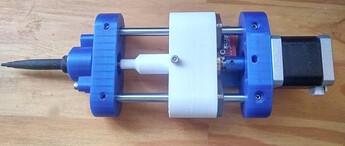A standard piezoelectric actuator is a little ceramic. You apply a high voltage (100V or so) to it and it changes in size a teeny tiny amount. They are very good for ultra-fine nano-fine positioning. You can make them in fun geometries to scan in x, y, and z.
However normally their translation is limited to about 1um or so. This is where the linear actuators come in. When I used to build these for scanning probe microscopes back when I worked in Nottingham we called them slip-stick motors. They work on a similar principle to the fancy trick where you pull a table cloth out fast and everything stays on the table.
Basically you make a stage that moves along some guide rails. The guide rails should be very smooth and hard. You want a fair clamping force between the two so it takes a fair push to move the stage along the rails. Attach the rails to your little piezoelectric actuator. You can now wobble the rails back and forth by a couple of microns.
Not the clever bit! Ramp the voltage from 0 to 100V slowly. The rails move about 1 micron, and the stage is attached and moves with it. Then as fast as you can ramp the voltage back down to 0. The rails move super fast slipping under the stage and the stage stays where it was. This is cool because you can now ramp the voltage from 0 to 100V slowly again moving it another micron. Then fast back leaving it where it is.
By applying a high saw-tooth signal to the rails you can move the stage all the way along them in tiny steps. You can also adjust the steps size, or make small movements.
We used to build 3 of them that sat on each-other for motion in all directions. You can even make ones with little legs that walk over ramps.
Is this what we need for OpenFlexure
The beauty of OpenFlexure is that the components are super cheap, and that the whole x/y/z mechanism prints in one part. This means we also have sub-micron steps due to the lever reduction in the flexures and the geared down motors, but it means that it significantly reduces assembly complexity which is so essential in our goal of wide production.
The downsize of the OpenFlexure mechanism is limited range of travel, and slow speeds. But for a 100x objective scanning it is pretty well optimised. Where OpenFlexure falls into problems is when you have lower magnification and want to move a bigger thing, faster and further. In this case we probably want to look less towards piezos and more towards 3D printer mechanisms. This is something that Niamh Burke has been doing with a microscope head that is hot-swappable with the hot end of a Ender 3D printer.
Using this for a syringe pump
It is an interesting idea to use these for a syringe pump. @naikymen, have you done any first tests?
My initial thought is that the slipstick motion relies on static friction perpendicular to the direction of motion, significant forces parallel to the motion are problematic. I have only ever used piezo actuators for positioning, never to impart a force on something else.
Parallel forces are not insurmountable, you can build an actuator that moves vertically (so gravity is parallel), but you need to be much more controlled over the clamping to make it work. What sort of volumes are you trying to shift and what speed? I would guess low volumes at low speed will be fine because the pressure will equalise.
![]() experiments, but we expect it to be reusable for a wider range of applications.
experiments, but we expect it to be reusable for a wider range of applications.![]()
